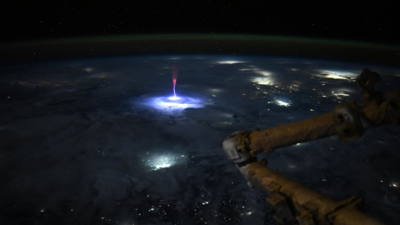Astronaut Captures Elusive Red 'Sprite' in Space, Boosting Atmospheric Research
While orbiting over North America, NASA astronaut Nichole Ayers photographed a rare and captivating sight: shimmering red lights in Earth’s upper atmosphere. This phenomenon, known as a Transient Luminous Event (TLE), or "sprite," manifested as a fleeting burst of red light above thunderstorms spanning Mexico and the United States.

_Sprite captured by Nichole Ayers (Image credits: X @AstroAyers)
Sprites are characterized as brief flashes of red light occurring high above powerful thunderstorms. These significant releases of electrical energy can extend up to 100 kilometers above Earth’s surface and are composed of "cold plasma," resembling the illumination within a fluorescent light more than typical lightning.
Due to their high altitude and short duration, sprites are rarely observed from the ground, making Ayers’ space-based observation particularly valuable.
Ayers shared the image on X, stating, “Just. Wow. As we went over Mexico and the U.S. this morning, I caught this sprite.”
She further elaborated, “Sprites are TLEs or Transient Luminous Events, that happen above the clouds and are triggered by intense electrical activity in the thunderstorms below.”
Sprites have long intrigued scientists and pilots alike. These fleeting, jellyfish-shaped flashes ascend into the atmosphere and disappear within milliseconds. For nearly a century, pilots reported sightings, but many scientists dismissed them as myths or optical illusions. This perspective shifted in 1989 when the first clear image of a sprite was accidentally captured on camera.
According to NASA, sprites occur when strong lightning discharges interact with Earth’s ionosphere. As the discharge travels upward and interacts with nitrogen molecules, it produces a reddish glow. Sprites are part of a broader category of upper-atmosphere phenomena, including blue jets and red elves.
The image shared by Ayers generated amazement and curiosity among viewers. One user commented, “Sprite.... one of the rarest of rare celestial phenomenon.”
Another user inquired, “How long do the sprites last? Is this a still shot taken from a video? What altitude did this one reach? The more we find out, it becomes obvious we know far less than we thought.”
Newer articles
Older articles
 Android Security Alert: Government Warns of Critical Flaws Exposing User Data
Android Security Alert: Government Warns of Critical Flaws Exposing User Data
 Bezos-Backed Methane-Tracking Satellite Mission Ends Prematurely After Loss of Contact
Bezos-Backed Methane-Tracking Satellite Mission Ends Prematurely After Loss of Contact
 Greg Chappell: Rishabh Pant is Revolutionizing Cricket with Unorthodox Batting
Greg Chappell: Rishabh Pant is Revolutionizing Cricket with Unorthodox Batting
 Sanjog Gupta Named ICC's New Chief Executive Officer, Set to Lead Cricket's Global Expansion
Sanjog Gupta Named ICC's New Chief Executive Officer, Set to Lead Cricket's Global Expansion
 Heart Attack Warning: 5 Subtle Signs to Watch for a Month Prior
Heart Attack Warning: 5 Subtle Signs to Watch for a Month Prior
 Gavaskar Calls for Kuldeep Yadav's Inclusion in Second Test Amid Bumrah Fitness Concerns, Eyes Batting Reshuffle
Gavaskar Calls for Kuldeep Yadav's Inclusion in Second Test Amid Bumrah Fitness Concerns, Eyes Batting Reshuffle
 Staying Hydrated May Significantly Lower Risk of Heart Failure, New Study Finds
Staying Hydrated May Significantly Lower Risk of Heart Failure, New Study Finds
 Asia Cup 2025: ACC Eyes September Start Date Amid Growing Optimism
Asia Cup 2025: ACC Eyes September Start Date Amid Growing Optimism
 Doctor Reacts to Rishabh Pant's Somersault After Century: 'Unnecessary!' – Surgeon Who Aided Recovery Speaks Out
Doctor Reacts to Rishabh Pant's Somersault After Century: 'Unnecessary!' – Surgeon Who Aided Recovery Speaks Out
 FIFA Club World Cup 2025: Upsets, Messi Magic, and Weather Woes Define Group Stage
FIFA Club World Cup 2025: Upsets, Messi Magic, and Weather Woes Define Group Stage